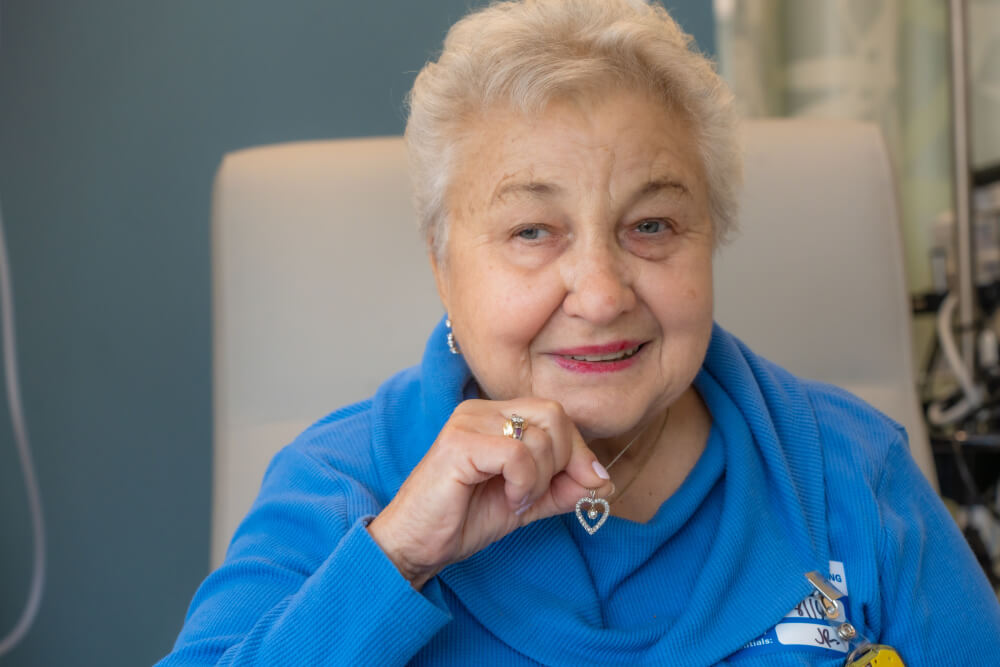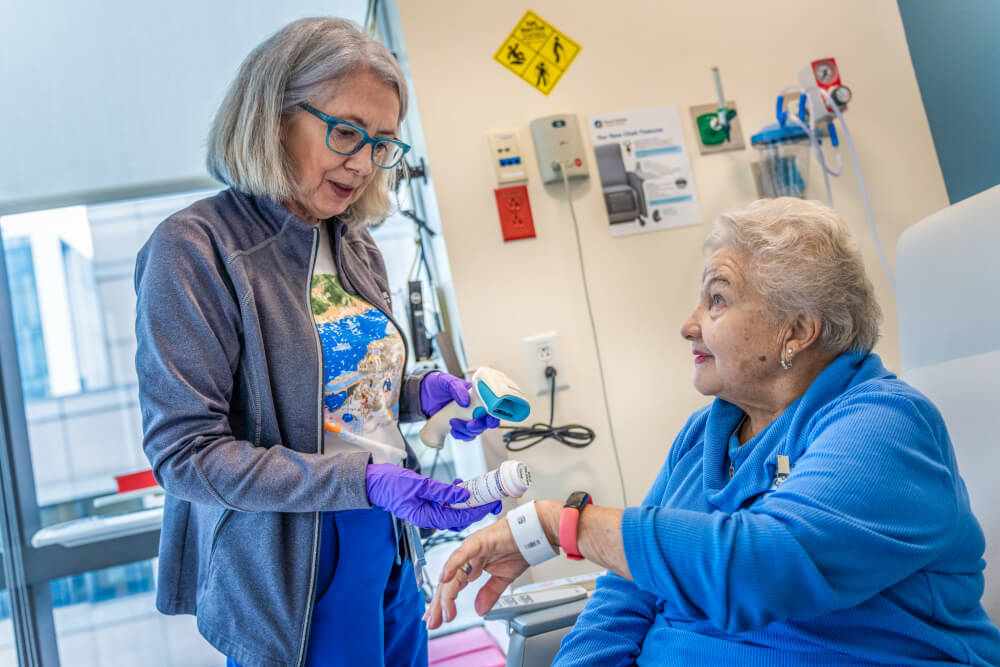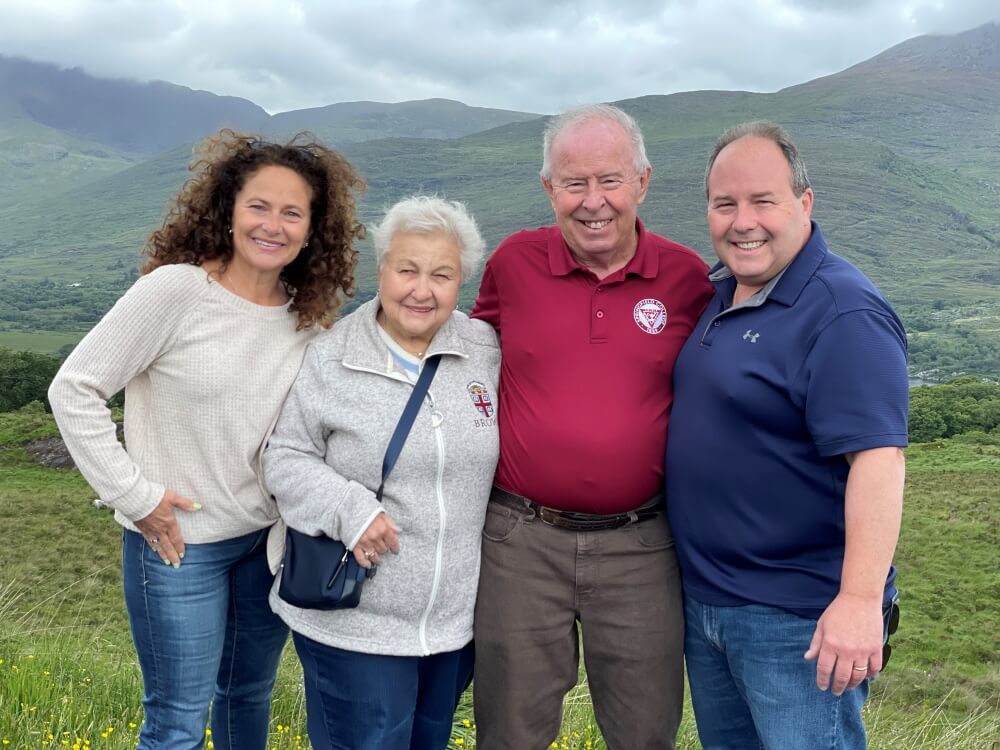In 2013, Camille Molloy had just returned from her annual winter trip to Marco Island, in Florida. She and her husband of 57 years, Pete, were carrying their luggage up the stairs, and she tripped.
A few weeks later, Molloy was still struggling to walk, so she went in for an X-ray. The image inadvertently captured a mass in her abdomen. She had early-stage ovarian cancer, a disease that is almost always discovered in later stages, after it has spread and become harder to treat.
She swears it was her late mother’s doing. “She pushed me up the stairs to keep me from going through what she did,” says Molloy, who is now 79 years old. Molloy’s mother had died in 2004, at age 89, just six months after her own ovarian cancer diagnosis.
Molloy, a retired bank administrator, has had two recurrences of ovarian cancer since that fateful trip up the stairs. But today, she is cancer-free. When her cancer came back most recently, in 2021, her doctors at Dana-Farber matched her to a clinical trial of a precision therapy that had not previously been tested in humans. She’s been on the medication and living life to its fullest ever since.
“I feel like a kid,” she says. “What are we doing next?”
Molloy says she couldn’t have made it through without the support of her family, especially her husband. She, however, is a central source of energy, courage, and connection that keeps the family together.

Three Annas and the Biscotti Hotties
About thirty years ago, Molloy’s mother, Anna, discovered she had breast cancer. She was in her 70s and received treatment at Dana-Farber. Shortly after her recovery, Molloy rallied her family — including aunts, uncles, cousins, siblings, children, and grandchildren, all living near her in Franklin, MA — to form a charity walking team in the American Cancer Society’s Relay for life, which in part helps to fuel their generous and longtime support for Dana-Farber.
They called themselves the Biscotti Hotties.
Molloy’s family is Italian. They follow a tradition where the first daughter in each family is named after the father’s mother. There have been several Annas in the family.
After the formation of the Biscotti Hotties, one of those Annas, a cousin, died of breast cancer. Soon after, another related Anna died of a different form of cancer. Then Molloy lost her mother Anna to ovarian cancer, two decades after her bout with breast cancer.
“It seemed like every year, we were losing an Anna,” says Molloy. “We always said we walked for the three Annas.”
Two of Molloy’s mother’s sisters had also died from ovarian cancer.
“She has a lot of breast and ovarian cancer in the family,” says Dana-Farber gynecologic oncologist Elizabeth K. Lee, MD, who is part of Molloy’s care team.
But from Molloy’s point of view, it didn’t seem that way. Molloy’s mother had three other sisters and a brother who all lived to see 100. Many people in her family have lived into their 90s. Given the variability in her very large family and the relative newness of the science behind inherited cancer risk, a genetic predisposition wasn’t on her radar.
When Molloy received her ovarian cancer diagnosis at Dana-Farber, her care team ran genetic tests on her blood and on the tumor to find genetic markers that might help guide treatment. Her blood showed that she had a mutation in RAD51C, a gene that must function properly for cells to repair broken DNA strands.
A RAD51C mutation is now known to increase the risk of breast and ovarian cancer. It runs in families the same way more well-known BRCA gene variants do. When one parent carries the mutation, each child has a 50% chance of also carrying it.
“Today this gene is well known to be related to many cancers,” says Lee. “It’s the reason we matched her to the trial she’s on now.”

Off to Italy, and Hawaii, and…
Back in 2013, when Molloy’s primary care doctor first noticed the tumor, things moved quickly. Molloy’s daughter, Suzanne, insisted on a trip to Dana-Farber, about an hour drive from their home. Within two weeks, Molloy had had surgery to remove the cancer along with her ovaries, fallopian tubes, and uterus. Soon after, in the fall of 2013, she began a four-month course of chemotherapy.
Her response to the chemotherapy was so good that she was able to have knee surgery to repair the damage from her fall up the stairs that same year. She also joined the family — a group of 11 people and three generations — on a trip to Italy.
“We all went off to Italy. Me with no hair, my knee operated on, just finishing chemo,” she says. “We had a wonderful time.”
In 2018, Molloy was thriving, and the family planned a trip to Hawaii to celebrate the 5-year mark, often a big milestone for cancer survivors.
About six months beforehand, however, Camille’s CA-125, a tumor marker associated with ovarian cancer, rose. Her oncologist, Joyce F. Liu, MD, MPH, ordered a CT scan which confirmed the news. Her cancer had come back.
“I’d been waiting for the other shoe to drop,” says Molloy, who endured another round of chemotherapy.
The family was, however, determined to get her to Hawaii. But the dates of their planned trip fell on the month of her last chemotherapy infusion. She consulted with Liu, who said, “go to Hawaii. We’ll figure it out.”
“Every time I leave Dana-Farber, I just feel so important,” says Molloy. “They just care so much about me and my life.”
Science advances
While Molloy and her family were busy living their lives, science marched on.
For instance, after completing chemotherapy a second time, Dr. Liu recommended that Molloy take olaparib, a PARP inhibitor, based upon recent clinical trial results and Molloy’s RAD51C mutation. In certain situations, PARP inhibitors are prescribed to patients like Molloy, whose cancers have mutations related to DNA repair. The drug works synergistically with disrupted DNA repair, breaking the repair process even more substantially and making cancer cells much less likely to survive.
Molloy took olaparib for two years before her third recurrence, in 2021.
Instead of another round of chemotherapy, Molloy’s oncologist, Liu, called Lee, who represents gynecologic oncology in the Center for Cancer Therapeutic Innovation (CCTI) which runs phase 1 clinical trials at Dana-Farber. Phase 1 trials offer patients an opportunity to try the most leading-edge treatments, from novel agents to combinations of novel and approved treatments. But they are also where these regimens are tested in humans for the first time.
Lee matched Molloy to a phase 1 trial of a novel drug called an ATR inhibitor. In 2021, the drug was known by its code name, RP-3500. It was designed to work similarly to olaparib, but differently enough that it could work even when olaparib had stopped working.
“It was an ideal scenario for Camille,” says Lee. “I asked her to think about it.”
Patients often fear that if they are offered a phase 1 trial, it’s the end of the line. “That’s not so,” says Lee. “Things have changed a lot over the years. We are better at getting the right drugs to the right patients. The science has progressed enough that for some patients we suggest a clinical trial early in their treatment course because it is so promising.”
“Phase 1 trials are an opportunity to leverage the latest tumor biology, the genomics, and the advancements in chemistry that make it possible for drug companies to make very sophisticated molecules,” says Geoffrey Shapiro, MD, PhD, senior vice president of developmental therapeutics at Dana-Farber. “These are not drugs of last resort.”
A living legacy
Molloy didn’t have to think about it.
She told Dr. Lee: “I have a daughter. I have granddaughters. If I can do something that is going to help them later down the road, why not?”
Within 5 months of starting therapy on the trial, Molloy’s cancer had shrunk substantially. Within a year, her tumors were completely gone.

The therapy, now called camonsertib, was initially being tested in patients with many types of solid tumors. Going forward, however, the pharmaceutical company that makes it will be developing it for ovarian cancer, in part due to how well Molloy has done while taking it.
“That means that other patients with ovarian cancer will be able to get it and hopefully some will benefit,” says Shapiro. “This is because of the participation of courageous volunteers like Camille.”
Last year, Molloy and her family went to Ireland. This coming winter, they’ve planned a river boat cruise in Europe to visit the Christmas Markets.
“I’ve got a lot of living to do,” she says.

How beautiful, dear Camille ❤️
Such an amazing, inspirational story of a remarkable woman. Auntie, you’re a true fighter
Thank you for posting this wonderful story while the Red Sox are conducting their annual fundraising events for Dana-Farber. Cousin Camille is a wonderful person, funny, kind, and a joy to be around. I have to think that her personality helped a lot in dealing with cancer. Her husband Peter and support system are strong and always there for her. As an Italian guy who knows all about family, I know that Auntie Anna, Camille’s mother, and Uncle Sam, her father, are watching over her as well. Thank you, Dana-Farber. How lucky are we to have that amazing, life-saving resource.
So very happy to call Camille and Peter our friends. The Molloys are a wonderful , warm loving family and I am so very glad that we can all enjoy and celebrate in Camill‘s progress through the years .❤️
What an inspiring article! Our children grew up together as neighbors over 50 years ago. Her resilience and enthusiasm were the same back then as we shared play group and scout experiences!
Prayers for all cancer victims.
Let’s hope for similar outcomes and happy endings.
Camille is one tough Lady!!
She certainly has had many hills and valleys and because of her will to Live and potential help others she is living her best life
Congratulations!!
I too am a cancer survivor & because of Dana Farber I get to see another day into years!! I had a Stem Cell transplant 8 years ago after being diagnosed with MDS
This is a heartwarming story of a family’s love and the brilliant, unwavering medical care of her oncologists.Camille is an incredibly inspirational, strong amazing woman with a zest for life that is incomparable. Reading this tonight reminds me of how precious life is and what a gift it is for someone to survive and thrive after what could have been the end of her life. Camille may God bless and protect you, your precious loved ones , friends and family and indefatigable love and kindness and your magnificent medical team. Sincerely, Ellen K. Talisman